Goetz-Höhle
Goetz’s Cave
Useful Information
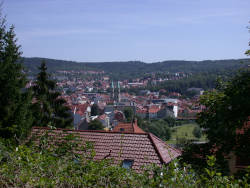
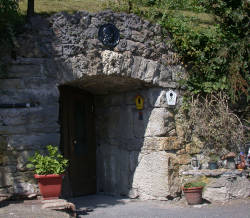
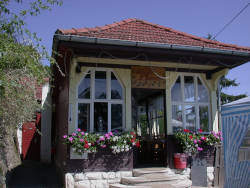
| Location: |
Am Dietrich 2, 98617 Meiningen.
In the city Meiningen. Parking at Am Mittleren Graben and Neu-Ulmer Straße. (50.563233, 10.406937) |
| Open: |
APR to OCT . APR bis OCT Sat, Sun 12-18. Berggasthaus "Zur Spalte": All year Thu, Fri 16-22, Sat 11-23, Sun 11-21. [2022] |
| Fee: |
Adults EUR 8, Children (6-16) EUR 5, Children (0-5) free, Seniors (65+) EUR 6. [2022] |
| Classification: |
 Tectonic Cave, Tectonic Cave,
 Fracture Cave,
lower Muschelkalk. Fracture Cave,
lower Muschelkalk.
|
| Light: |
 LED LED
|
| Dimension: | L=110 m, VR=30 m, A=328 m asl. |
| Guided tours: | L=450 m, VR=40 m, V=15,000/a [2000]. |
| Photography: | allowed |
| Accessibility: | no |
| Bibliography: |
Anon (2001):
Goetz-Höhle Meiningen,
Thüringer Landesanstalt für Geologie, Weimar, 2001, ISBN 3-9806811-2-2.
Erhältlich von der Tourist-Information Meiningen.

Prof. Dr. Heß von Wichdorff, Prof. Dr. A. Goetze (1928): Thüringer Höhlen, Zeitschrift des Thüringer Höhlen-Vereins, 1. Jahrgang 1928, Hefte 1 und 2 in einem Band. 
|
| Address: |
Goetz-Höhle, Am Dietrich 2, 98617 Meiningen, Tel: +49-152-53219508.
E-mail: Camping- und Anglerparadies Reich am Schnackensee GmbH & Co. KG, Schnackenmühle 2-4, 91710 Gunzenhausen, Tel: +49-9831-5169985. E-mail: Information and bookings: Tourist-Information Meiningen, Bernhardstraße 6, D-98617 Meiningen, Tel: +49-3693-44650. E-mail: |
| As far as we know this information was accurate when it was published (see years in brackets), but may have changed since then. Please check rates and details directly with the companies in question if you need more recent info. |
|
History
| AUG-1915 | discovered by the merchant Reinhold Goetz from Meiningen during works in his garden. |
| 1917 | remains of bison, bear and wild horses discovered. |
| 1922 | first explored by the Thüringer Höhlenverein (Cave Club Thüringen). |
| 1925 | Entrance gallery completed, first visits by friends and interested parties. |
| 31-DEC-1925 | Reinhold Goetz passes away, cave remains closed. |
| OCT-1931 | visit by the state geologist Heß von Wichdorff. |
| 23-APR-1932 | members of the Thuringian Caving Society, the Mayor of Meiningen Hermann Keßler and other representatives of the city as well as caving enthusiasts of the Henneberg-Franconian Historical Society visited the cave. |
| MAY-1932 | start of development. |
| 21-APR-1934 | show cave inaugurated. |
| 1938 | cave and mountain garden bought by Breede family and continued to operate. |
| 30-OCT-1940 | protected as a natural monument under the Reich Nature Conservation Act by decree of the district administrator. |
| 20-AUG-1955 | protect as a Bodendenkmal (natural monument). |
| 1956 | Protection as a geological natural monument. |
| 24-JUL-1970 | closed due to alleged safety deficiencies. |
| 11-AUG-1983 | declared a Geological Natural Monument (GND) by the Meiningen District Council with resolution number 510/73/83. |
| 13-SEP-1996 | Verein (non profit association) Goetz-Höhle Meiningen e.V. is founded. |
| 22-APR-2000 | electric light and reopened. |
| 2009 | lighting converted to LED. |
| 2012 | restaurant closed for renovation. |
| 2014 | reopening with new tenant and renovated Baude. |
| 2016 | cave closed and was up for sale. |
| 2020 | sold to entrepreneur and brewery owner Volker Reich. |
| 03-JUL-2021 | reopened under new management. |
Description
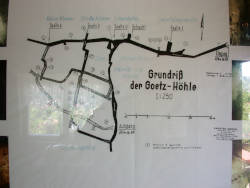
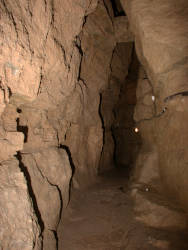
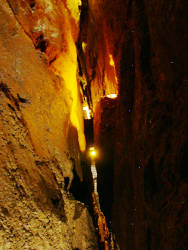
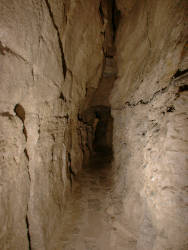
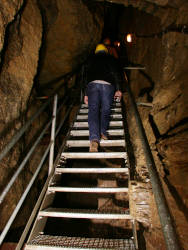
The Goetz-Höhle (Goetz’s Cave) is located south of Meiningen, on the eastern slope of the Dietrichsberg towards the Werra river. The large hillside property belonged to the Meiningen merchant Reinhold Goetz and he was in the process of designing a mountain garden with terraces, outlooks and an artificial castle ruin. The redesign to suit the romantic taste of the time required considerable earthworks, and while digging away stones Goetz came across a large opening in the fossil rich limestone. He was able to enter the cave and reached a crevice running parallel to the mountainside, now known as Main Crevice 2. He was very impressed by the cave and wanted to develop it as a show cave. Over the next two years, he built an artificial entrance tunnel, which today serves as the cave exit. In the process, he entered Main Crevice 3 and 4, and discovered animal and human bones embedded in the cave clay in Main Crevice 3. The extension of the access tunnel lasted until 1925, presumably Goetz carried out the work himself, after which friends of the family and other interested people visited the cave. At the end of the year, however, Reinhold Goetz died and the development work was stopped.
Things got moving again with a publication by the Thuringian Caving Association. They started a journal in 1928 with the title Thuringian Caves, the regional geologist Heß von Wichdorff was editor. In October 1931, he visited the cave and then mentioned the crevasses in the Dietrichsberg in the next issue of the magazine, describing them as "the most important fissures in Thuringia". This led to a visit on 23 April 1932, when members of the Thuringian Caving Association, the mayor of Meiningen Hermann Keßler and other representatives of the city as well as caving enthusiasts from the Henneberg-Franconian History Association visited the cave. Heß von Wichdorff explained the geological conditions and the formation of the cave and suggested to continue the development as soon as possible. Obviously, his idea fell on fertile ground, because further development of the cave began as early as May. Martha Goetz, the discoverer’s widow, financed the further development work and was advised by the two associations. The mining engineer Hermann Bender from Blankenburg (Harz) was the technical director and was supported by Erich Marquardt, a teacher at the Gymnasium Bernhardinum Meiningen. Intensive construction work followed, with more than 20 workers involved in the extension. During the construction of today’s entrance, further crevices were discovered, Main Crevice 1 and other secondary crevices. The crevices were cleared out and 7,000 m³ of rubble was removed from the cave. In the process, numerous artefacts from the Stone Age and skeletal parts of post-glacial animals were found in the sediment layers. Finally, stairs made of oak wood and electric lighting were installed. After almost two years of work, the cave was opened as a show cave on 21-APR-1934.
The cave was operated as a show cave for many decades, surviving National Socialism, World War II and the building of the Wall. But in 1970, out of the blue, the cave was closed, citing "imminent ridge failures". The owners of the cave received no official explanation. There is also no written evidence of this. Nevertheless, the two cave entrances were bricked up. Neither the monument authorities nor the owners were able to get the closure lifted. The reason for the cave’s closure is thought to be its proximity to the inner-German border and its private ownership. Since the cave was privately owned, the authorities could not control it directly. However, whether the authorities feared that an escape tunnel could be dug from the cave or whether they feared that it could serve as a safe house for a GDR version of the Underground Railroad is not kown. From today’s perspective, the whole thing is rather ridiculous, but it was definitely economically problematic for the cave operators at the time.
After the German reunification, the cave remained closed for the time being, and for many reasons. First and foremost, the wooden stairs and the electric lighting were no longer usable. At the beginning of the 1990s, the lower nature conservation authority of the Meiningen district commissioned an expert opinion on the cave’s worthiness for protection. This was necessary because the 1983 decision lacked a conservation assessment and treatment guidelines. At the same time, the Thuringian State Office for the Preservation of Archaeological Monuments (TLAD) in Weimar began a new processing of the archaeological material. In 1996, a company for mining safety from Ilfeld drew up an expert report according to which the cave posed no safety risks and could be reopened at any time. Obviously, they had not examined the touristic aspects.
The citizens of Meiningen still remembered the Goetz Cave very well and in December 1995, nine committed people from Meiningen founded an initiative to reopen the cave. The surface area of the Goetz Cave, the Berggarten with about 21,000 m², was owned by a community of heirs. They signalled their intention to sell and on 26 April 1996 the site was acquired by the Goetz Cave initiative. The Goetz-Höhle e.V. association with 42 members was founded on 13 September 1996 with the goal of reopening the Goetz Cave. The main problem was the financing of the necessary measures. After all, the state labour office contributed about one million euros. Further funds came from the Thuringian State Office for the Preservation of Monuments and Archaeology in Weimar, the town of Meiningen and several business people. The work took place from June 1999 to January 2000. New paths and stairs, new electric lighting, railings and safety nets against falling rocks were installed. The outside area of the cave was also made visitor-friendly. The inauguration took place on 22 April 2000, the date now having become something of a tradition.
Over the next few years, the cave was steadily renovated and run by different tenants with varying degrees of success. The last tenant was very ambitious, but he unfortunately gave up after only two years in 2016. Therefore, the cave was closed and put up for sale. It was finally sold in 2020 to the entrepreneur and brewery owner Volker Reich. He has big plans for the cave and reopened the cave in 2021. New features include the spooky tour and the 100-metre-long marble run in the outdoor area, and the Baude has been renamed "Zur Spalte" mountain inn.
The great feature of this cave is, that it is a fracture cave, a sort of tectonic cave. This is extremely rare; the Goetz Cave is the only fracture cave in Europe that has been converted into a show cave. It is also the largest crevice cave in Germany and Europe (not including Scandinavia). The largest crevice is 50 m long, 50 m high and up to 3 m wide. The effusive praise by Prof. Dr. Heß von Wichdorff in 1932 is still valid today.
The Dietrichsberg is the eastern end of the so-called Meininger Triasland, also known as the Meininger Limestone Plates. An extensive Muschelkalk plateau between the Grabfeld and the Werra valley near Meiningen. Here a relatively steep valley slope was formed by the erosion of the Werra. The fissur rich limestones and calcareous marlstones of the Lower Muschelkalk lie largely horizontally on the relatively impermeable Upper Red Sandstone (Röt). Water seeped through the fissures and accumulated on the Röt. This led to chemical weathering and softened the sandstones, and the limestone blocks, already separated by the fissures, slid downhill on this lubricant. While they slid by 3 m at the base, they tilted towards the slope at the top, creating the typical fissures that wedge out towards the top. However, as the fissures did not close tightly along their entire length, there were openings to the surface through which earth material, plant debris and even animals fell into the fissure and slowly filled it. The staggered individual blocks formed four main fissures parallel to the slope and twenty secondary fissures.
The guided tour begins at the lower access tunnel, right next to the cave hut, which is operated as a restaurant with a beer garden. This gallery is 110 m long and connects all four main crevices at 328 m above sea level. The tour walks along the Main Crevice 2 to the end and changes to the Main Crevice 3 through a cross-cut. Through it they return to the lower access tunnel and follow it to the fourth main crevice. There they ascend via metal stairs and then cross the Main Crevice 3 to the Main Crevice 2 on the middle floor. After following this for a short distance and tour returns to the Main Crevice 3 through another cross-cut. Here you climb further stairs, which become increasingly narrower. Finally, you leave the cave through a short tunnel, the one through which Reinhold Goetz originally discovered and opened up the cave.
 Search DuckDuckGo for "Goetz-Höhle"
Search DuckDuckGo for "Goetz-Höhle" Google Earth Placemark
Google Earth Placemark Goetz-Höhle
Goetz-Höhle  Goetz-Höhle, official website
Goetz-Höhle, official website  Index
Index Topics
Topics Hierarchical
Hierarchical Countries
Countries Maps
Maps